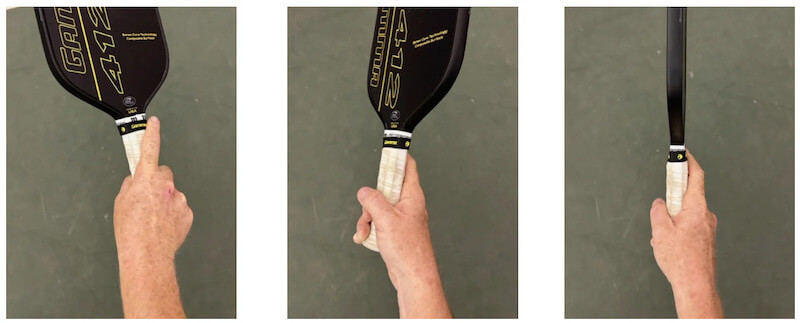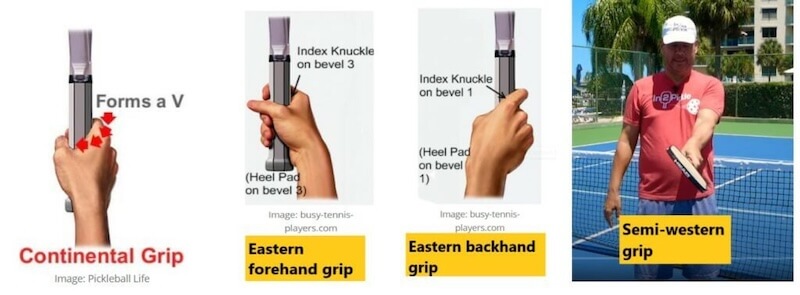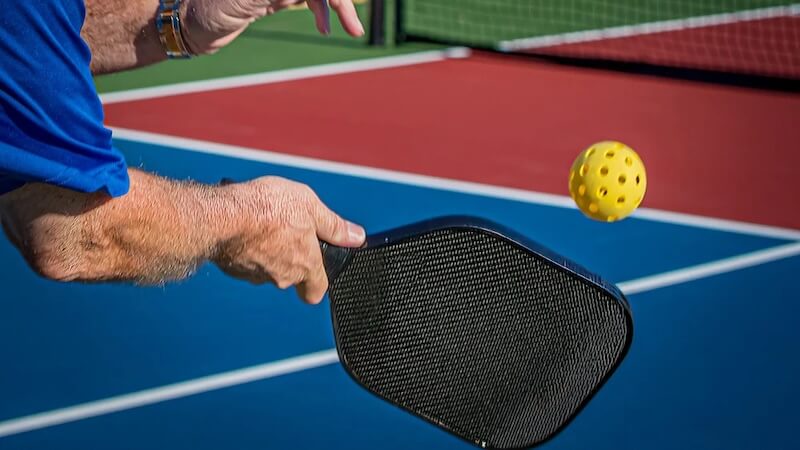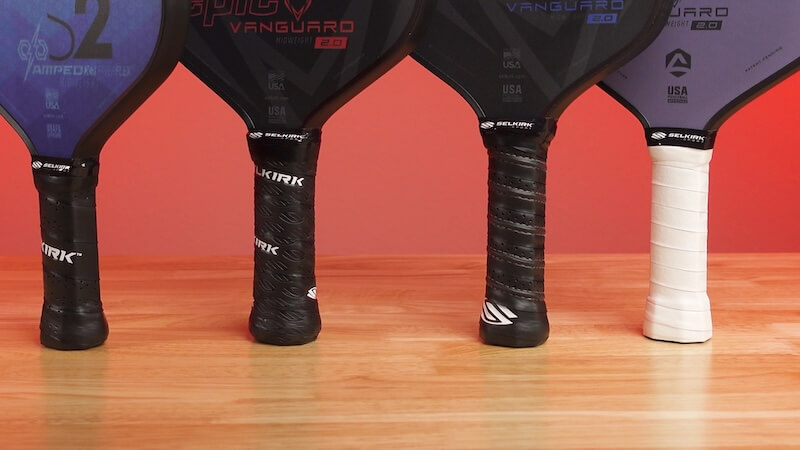When I first started playing pickleball, I thought learning how to hold a pickleball paddle would be simple – just grab the handle and swing. But after struggling with inconsistent shots, I realized that knowing how to hold a pickleball paddle properly makes all the difference between frustrating games and enjoyable ones. Understanding how to hold a pickleball paddle correctly is fundamental to developing good technique.
If you’re new to pickleball and want to understand the game’s fundamentals before diving into grip techniques, check out our Complete Pickleball Play Guide: Origins and Official Rules for a comprehensive overview of the sport’s basics.

Why Proper Grip Matters
The way you hold your pickleball paddle affects every aspect of your game. Getting your grip right allows you to hit the ball firmly and helps generate power and direction accurately. When you know how to hold a pickleball paddle correctly, you can hit the full range of shots needed to play better pickleball.
Poor grip leads to inconsistent shot placement, reduced power on drives, difficulty controlling soft shots, and increased hand fatigue.
The Three Main Paddle Grips
Learning how to hold a pickleball paddle involves understanding the three standard grip styles used by players at all levels.
Continental Grip: The Foundation
The Continental grip is the most common way to hold a pickleball paddle, especially for beginners. This grip is also known as the “hammer grip” since you hold the paddle like you would hold a hammer.
How to find the Continental grip:
- Place the V formed between your thumb and index finger on top of the paddle handle
- Position the knuckle of your index finger on the second bevel (the corner bevel to the right for righties)
- This creates a “hammer grip” position as if you’re holding a hammer to hit a nail
- For left-handed players, place your knuckle on the second bevel to the left instead
This neutral grip works well for both forehand and backhand shots without requiring grip changes. When you properly understand how to hold a pickleball paddle with the Continental grip, you’ll find it offers excellent versatility for most playing situations.
Continental grip advantages:
- Excellent for dinks and soft shots
- Strong backhand position
- Great for volleys and blocks at the net
- No grip changes needed between shots
- Ideal for kitchen line play
Continental grip disadvantages:
- Less powerful on forehand drives
- Limited topspin generation
- Paddle face naturally more open
Eastern Grip: The Popular Choice
The Eastern grip has become increasingly popular and is often considered the best way to hold a pickleball paddle for most players. This grip is sometimes called “shaking hands with the paddle” because of how naturally it feels.
How to find the Eastern grip:
- Hold your paddle directly out in front of you with your opposite hand
- The paddle face should look evenly to the left and right of your body
- Place your playing hand on the paddle face and slide it down to “shake hands” with the grip
- Position the knuckle of your index finger on the third bevel (one bevel over from Continental)
- This is often called the “handshake grip” because of how natural it feels
Many advanced players prefer this method of how to hold a pickleball paddle because it provides excellent balance between power and control.
Eastern grip advantages:
- Most versatile for all shot types
- Excellent balance between forehand and backhand power
- Great for topspin generation
- Preferred by many professional players
- Natural paddle face position for drives
Eastern grip disadvantages:
- Slightly more complex than Continental for beginners
- May require minor adjustments for specialized shots
- Less ideal for pure net play than Continental

Western Grip: The Specialty Option
The Western grip represents a more extreme way to hold a pickleball paddle and resembles holding a frying pan. This grip is less common but still seen around courts.
How to find the Western grip:
- Place your paddle flat on the ground
- Reach down and pick it up like you would a frying pan
- The paddle face should be completely flat
- You should see the back of your knuckles when looking down
Understanding how to hold a pickleball paddle with the Western grip can be useful for certain situations, though it’s not recommended as a primary grip for most players.
Western grip advantages:
- Excellent for generating topspin on forehands
- Powerful forehand shots
Western grip disadvantages:
- Very weak backhand position
- Limited versatility
- Difficult to change to other shots quickly
Grip Pressure and Control
Knowing how to hold a pickleball paddle isn’t just about hand position – grip pressure plays a crucial role in performance. Many players, especially beginners, make the mistake of gripping their paddle too tightly.
Optimal Grip Pressure
The ideal grip pressure when learning how to hold a pickleball paddle is around 3-4 on a scale of 10. Professional coaches consistently recommend this lighter pressure. Think of holding a small bird – firm enough to control it but not so tight that you hurt it.
Benefits of proper grip pressure:
- Better feel for the ball
- Improved wrist flexibility
- Reduced hand fatigue
- Enhanced touch on soft shots
- Ball stays on paddle face longer for better control
Adjusting Pressure for Different Shots
Advanced players adjust their grip pressure based on the shot they’re hitting:
Soft grip (3-4/10) for:
- Dink shots at the net
- Third shot drops
- Reset shots and blocks
- Defensive returns
Firm grip (6-7/10) for:
- Powerful drives and serves
- Overhead smashes
- Attacking volleys
- When you need added stability
Never use 8-10/10 pressure as this creates tension and reduces control.

Advanced Grip Techniques
As you become more comfortable with how to hold a pickleball paddle, you can explore these advanced techniques:
Index Finger Positioning
You have two options for your index finger when learning how to hold a pickleball paddle:
Finger around the handle:
- Wrap all fingers around the grip
- Provides more wrist manipulation
- Better for power shots and spin
- More stability for beginners
Finger extended up the paddle:
- Place index finger on the back of the paddle face
- Offers enhanced control and touch
- Popular among advanced players
- Risk of ball hitting finger on backhand shots
Grip Size and Customization
Understanding how to hold a pickleball paddle also involves finding the right grip size for your hands. Pickleball paddle grips typically range from 4 to 4.5 inches in circumference.
Finding Your Ideal Grip Size
Simple test:
- Grip your paddle normally
- Try to slide your other index finger between your fingertips and palm
- Your finger should fit snugly without forcing it
Many players customize their grip using overgrip tape to increase thickness or replacement grips for different textures.

Common Mistakes to Avoid
When learning how to hold a pickleball paddle, watch out for these frequent errors:
Gripping Too Tightly
This is the most common mistake. A “death grip” restricts wrist movement and reduces both control and power. Many players, especially beginners, grip at 8-9/10 when they should be at 3-4/10. Remember that knowing how to hold a pickleball paddle includes maintaining relaxed grip pressure.
Holding in Palm Instead of Fingers
Grip the paddle more in your fingers rather than your palm. This provides better sensitivity and control over your shots.
Using Tennis or Ping-Pong Grips
While these work for other sports, pickleball requires more versatility. The unique nature of pickleball shots demands specific grip techniques.
Inconsistent Grip Position
Constantly changing where you hold the paddle makes it difficult to develop muscle memory and consistent shots.
Choosing the Right Grip for You
The best way to hold a pickleball paddle depends on several factors:
Playing Style Considerations
Power players: Eastern or Continental grips provide good power generation Control players: Continental grip offers excellent touch and placement All-court players: Eastern grip provides the best versatility
Physical Factors
Hand size: Affects grip size selection and finger positioning preferences Strength: Influences optimal grip pressure and style choice Flexibility: Determines comfort with different grip positions
Final Thoughts on Paddle Grips
Learning how to hold a pickleball paddle correctly is one of the most important fundamentals in the sport. Whether you choose Continental, Eastern, or even experiment with Western grip, the key is finding what feels comfortable and allows you to play your best.
Most players find that the Eastern grip offers the best combination of power, control, and versatility. However, the Continental grip remains an excellent choice for beginners and provides a solid foundation for developing other grips later.
Take time to experiment with different ways to hold a pickleball paddle during practice sessions. What works for other players might not work for you, and that’s perfectly fine. The goal is finding a grip that feels natural, allows consistent shot-making, and supports your preferred playing style.
Remember that proper grip is just the foundation – combine it with good footwork, positioning, and strategy to truly elevate your pickleball game. Master how to hold a pickleball paddle correctly, and you’ll be amazed at how much your overall performance improves.

